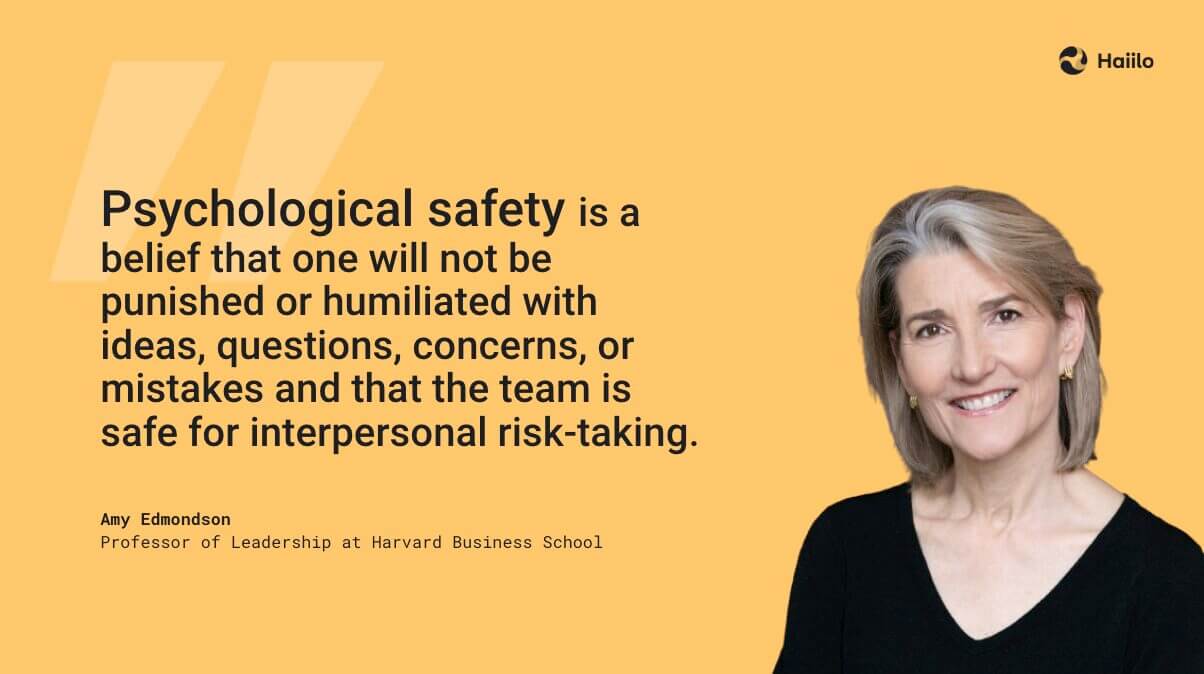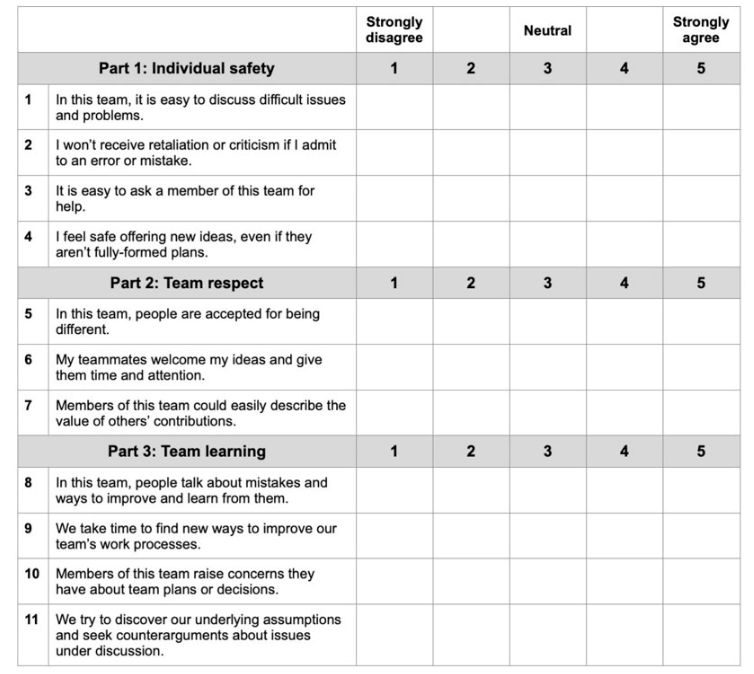Psychological safety in the workplace is one of the most important drivers of employee motivation, engagement, and productivity.
In fact, it is an employee experience factor that directly influences employee happiness, retention, and ambassadorship.
Employees who feel psychologically safe are more likely to have good relationships with their peers and managers, tend to go the extra mile to achieve great results, are better team players, and are unlikely to demonstrate quiet quitting behaviors.
Furthermore, building a culture of psychological safety is a critical component for promoting diversity, equity, and inclusion.
In this blog, we will define psychological safety, explain its benefits, and cover some best practices for improving psychological safety in the workplace.
What Is Psychological Safety
Amy Edmondson, a leading researcher in psychological safety, defines it as:

In other words, a psychologically safe workplace is a place where employees feel safe and encouraged to share their ideas, express concerns, ask questions, suggest improvements, and learn from mistakes. It’s a workplace where employees know they can always share their voice without fear of retribution, punishment, or embarrassment.
Such workplaces enjoy a positive workplace culture which enables every person to strive and achieve their best. Consequently, these workplaces see much more creativity from their people, innovative ideas, and better workplace relationships.
Additionally, there are incredible downsides of not having psychological safety, including negative impacts on employee well-being, including stress, burnout, and turnover, as well as on the overall performance of the organization.
Let’s now dig deeper into the importance of psychological safety in the workplace.
Improve psychological safety in your company with Haiilo communications platform!
The Importance of Psychological Safety In the Workplace
According to McKinsey, an overwhelming 89% of employee respondents say they believe that psychological safety in the workplace is essential.
But what makes it so important?
1. Better motivation and performance
Above everything else, psychological safety leads to employees feeling more engaged and motivated in their jobs. Because they feel that their contributions matter and that they can share their voice without fear, they are more likely to be engaged and involved in different projects.
This is also backed by research. In a research study with nearly 300 leaders over 2.5 years, it was found that teams with high degrees of psychological safety reported higher levels of performance and lower levels of interpersonal conflict.
2. Lower turnover and less quiet quitting behaviors
According to the 2022 State of Talent Optimization Report, one in four companies say psychological safety is the top driver of employee retention.

When employees feel like they are not heard and that their words are not taken into consideration, they are also more likely to demonstrate quite quitting behaviors. Meaning, they just perform their minimum to keep the job, but have no motivation to achieve great results.
3. Continuous learning and more innovation
When employees feel comfortable trying new things and learning from mistakes, this can foster a culture of continuous learning, innovation, and improvement.
Colleagues who feel their work environment is psychologically safe are more willing to think out of the box and contribute to greater organizational innovation.
4. Improved wellbeing and mental health
Over 80% of employees say they prefer good mental health over a high-paying job, illustrating the importance of a healthy work environment.
Employers and leaders who promote and care about psychological safety are, therefore, more likely to see better employee well-being, improved employee morale, and mental health.
5. Enhanced team collaboration
As Mark Mortensen and Amy Edmonson highlight in their article Without Psychological Safety, Hybrid Work Won’t Work, psychological safety at work allows for better team communication and collaboration.
Without psychological safety, individuals are less likely to share information, leading to organizational silos and poor workplace communications. On the other hand, psychologically safe team members feel comfortable reaching out to their colleagues and asking for help without fear.
6. Ambassadorship and advocacy
Workplaces that nurture transparency and care about employees’ psychological safety are also more likely to have employees as brand ambassadors.
But why should you care about employee advocacy? Check out our blog to find out!
7 Steps to Create Psychological Safety at Work
Now that you understand the value and benefits of psychological safety, let’s go over some best practices for creating, managing, and nurturing psychologically safe workplace culture.
1. Understand the current state of psychological safety
Before you begin to implement new initiatives to improve psychological safety in your organization, you first need to understand the current state of it as well as the factors shaping your employees’ perception of psychological safety.
The best and easiest way to get these insights is by distributing an employee survey with relevant questions.
If you are not sure how to get started, you can always use the statements from Dr Edmondson’s original research.

2. Assess your managers’ leadership and communication styles
Today, people are 10 times more likely to quit their jobs because of toxic work cultures — rather than compensation or work-life balance — and three in four people say their boss is the most stressful part of their jobs.
Leadership styles and the way leaders manage and communicate with their teams can make a significant difference in improving psychological safety among their teams. Transformative, servant, and empathetic leaders are known to have happier teams and a more positive team culture.
Furthermore, one research confirmed that leader-motivating language is positively related to psychological safety, job meaningfulness, psychological availability, and employee advocacy in the United States and India.
3. Build trust in the workplace
Workplace trust is the bedrock of psychological safety. Without it, employees may feel unsure about sharing their ideas or raising their concerns. A lack of trust can arise from various factors, such as inconsistent communication, lack of workplace transparency, perceived favoritism, or a history of ignored feedback.
Because the most negative consequence of lack of trust is low employee engagement, many organizations have been focusing on improving psychological safety to achieve greater trust from their employees.
4. Improve workplace communications
Ineffective, inconsistent, or inadequate communication can lead to misunderstandings and a lack of clarity. If team members feel they’re not receiving transparent or consistent communications from their employer and leadership, they may not feel safe expressing their thoughts or concerns.
In large organizations, information and messages get lost or neglected unintentionally. The amount of workplace technologies and communication channels they use can lead to information loss and overload.
So modern internal communications professionals are tasked with making workplace communications more streamlined, efficient, and engaging by using the latest internal communications technology.
📹 Check out our Masterclass: Why You Need an Internal Comms Strategy
5. Encourage share of voice and create space for new ideas
The biggest reason why employees may not feel psychologically safe is because they are not encouraged or supported to share their voices.
Unfortunately, many people feel this way. According to a Gallup poll, just 3 out of 10 employees strongly agreed that their opinions count at work.
A recent survey from Catalyst also found that nearly half of female business leaders face difficulties speaking up in virtual meetings, and 1 in 5 reported feeling overlooked or ignored during video calls.

These statistics are alarming, and employers need to do a better job of training their leaders to be more supportive and encourage their people to speak up.
Managers should make sure to involve people in decision-making and take into consideration new ideas, suggestions, and criticism. They need to create an open space for everyone to innovate and try new things.
6. Think about how you handle failure and provide constructive feedback
The way failure is handled in your organization can have a significant (if not the biggest) impact on the level of psychological safety.
People who are willing to experiment, try new things, or take reasonable risks shouldn’t be punished immediately.
Otherwise, the fear of consequences will block them from future engagement and innovation. When employees fear that sharing ideas, asking questions, or admitting mistakes will lead to ridicule, punishment, or negative judgments, they’re unlikely to feel psychologically safe.
Instead, managers need to make sure that they provide frequent, timely, and constructive feedback.
7. Celebrate and recognize new ideas
Show recognition that learning from mistakes is an opportunity for growth and career development. Instead of punishments, encourage learning from failure by giving meaningful recognition.
A simple non-monetary recognition program can help encourage innovation, instead of sabotaging it. Make sure that the recognition is visible to everyone and that employees can join the conversation and celebrate together.
You can even consider having a #kudos or a #thanks channel where peers can send kudos to each other, or implement a monthly company newsletter celebrating those who bring new ideas to the table.










